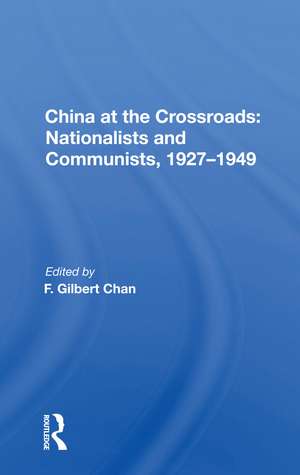China at the Crossroads: Nationalists and Communists, 1927-1949
Editat de F. Gilbert Chanen Limba Engleză Paperback – 23 noi 2020
| Toate formatele și edițiile | Preț | Express |
|---|---|---|
| Paperback (1) | 389.38 lei 6-8 săpt. | |
| Taylor & Francis – 23 noi 2020 | 389.38 lei 6-8 săpt. | |
| Hardback (1) | 768.30 lei 6-8 săpt. | |
| Taylor & Francis – 7 iun 2019 | 768.30 lei 6-8 săpt. |
Preț: 389.38 lei
Nou
Puncte Express: 584
Preț estimativ în valută:
74.52€ • 80.91$ • 62.59£
74.52€ • 80.91$ • 62.59£
Carte tipărită la comandă
Livrare economică 23 aprilie-07 mai
Preluare comenzi: 021 569.72.76
Specificații
ISBN-13: 9780367171063
ISBN-10: 0367171066
Pagini: 280
Dimensiuni: 152 x 229 x 18 mm
Greutate: 0.45 kg
Ediția:1
Editura: Taylor & Francis
Colecția Routledge
Locul publicării:Oxford, United Kingdom
ISBN-10: 0367171066
Pagini: 280
Dimensiuni: 152 x 229 x 18 mm
Greutate: 0.45 kg
Ediția:1
Editura: Taylor & Francis
Colecția Routledge
Locul publicării:Oxford, United Kingdom
Cuprins
Introduction: China at the Crossroads, 1927–1949 Part 1: The Nationalists, 1927–1937: A Case Study of Revolutionary Failure 1. Factional Politics in Kuomintang China, 1928–1937: An Interpretation 2. The New Life Movement before the Sino-Japanese Conflict: A Reflection of Kuomintang Limitations in Thought and Action 3. Agrarian Reform in Nationalist China: The Case of Rent Reduction in Chekiang, 1927–1937 4. China's Vulnerability to Japanese Imperialism: The Anti-Japanese Boycott of 1931–1932 Part 2: Sinkiang and Szechwan in the Era of Japanese Aggression 5. Regionalism and Central Power: Sheng Shih-ts'ai in Sinkiang, 1933–1944 6. The Kuomintang and Rural China in the War of Resistance, 1937–1945 Part 3: The Communists, 1927–1949: In Search of Revolutionary Models 7. The Origins of Communist and Soviet Movements in China 8. Chinese Communist Land Reform and Peasant Mobilization, 1946–1948
Descriere
Concentrating on a transitional epoch, 1927–1949, when China was at the crossroads of revolution, this book analyzes the Kuomintang's inherent weaknesses as a revolutionary force and the Communists' success in the quest for new formulas to guide the modernization movement.
